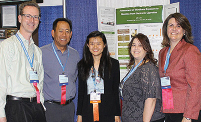Lily Wei Lee, a high school senior at Stuyvesant High School in New York City, was named the recipient of the top Addiction Science Award at the 2014 Intel International Science and Engineering Fair (ISEF) for her project, “Assessment of Third-Hand Exposure to Nicotine from Electronic Cigarettes.” The Intel ISEF Addiction Science Awards were presented at a ceremony held recently at the Los Angeles Convention Center.
Third-Hand Exposure
The 18-year-old wondered whether e-cigarette use could pose a risk of third-hand exposure, where nicotine from vapors sticks to surfaces to affect nonusers even if they aren’t exposed to the e-cigarette use. She took three brands of e-cigarettes and filled them with varying nicotine concentrations. Using a syringe to ensure consistent puffs, e-cigarettes were “vaped,” after which nicotine concentrations were measured from surrounding surfaces—a glass window, vinyl walls, tiled floor, metal, and wood.
Ms. Lee found significant increases in the amount of nicotine on all five surfaces; the floor and window had the greatest nicotine levels. The amount of residual nicotine depended on the particular brand used.
She hopes to next explore whether e-cigarette use is related to increased third-hand exposure to cancer-causing agents.
“This bright, young scientist showed that nonusers can be exposed to nicotine residue from just one e-cigarette, even if the e-cigarette usage occurred some time ago,” said Nora D. Volkow, MD, Director of the National Institute of Drug Addiction (NIDA), part of the National Institutes of Health, which coordinates the Awards. “Chronic e-cigarette use would be expected to produce even higher levels of third-hand nicotine exposure, and it’s unclear how such exposure could impact the health of close family members, friends, and coworkers who are regularly exposed to these environments.” ■


